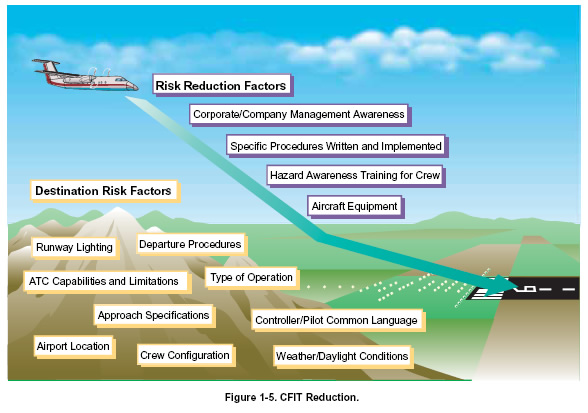 |
|
| INSTRUMENT PROCEDURES HANDBOOK |
|
SYSTEM SAFETY Although hoping to decrease delays, improve system capacity, and modernize facilities, the ultimate goal of the NAS Plan is to improve system safety. If statistics are any indication, the beneficial effect of the implementation of the plan may already be underway as aviation safety seems to have increased in recent years. The FAA has made particular emphasis to not only reduce the number of accidents in general, but also to make strides in curtailing controlled flight into terrain (CFIT) and runway incursions as well as continue approach and landing accident reduction (ALAR). The term CFIT defines an accident in which a fully qualified and certificated crew flies a properly working airplane into the ground, water, or obstacles with no apparent awareness by the pilots. A runway incursion is defined as any occurrence at an airport involving an aircraft, vehicle, person, or object on the ground that creates a collision hazard or results in a loss of separation with an aircraft taking off, attempting to take off, landing, or attempting to land. The term ALAR applies to an accident that occurs during a visual approach, during an instrument approach after passing the initial approach fix (IAF), or during the landing maneuver. This term also applies to accidents occurring when circling or when beginning a missed approach procedure. ACCIDENT RATES The NTSB released airline accident statistics for 2004 that showed a decline from the previous year. Twentynine accidents on large U.S. air carriers were recorded in 2004, which is a decrease from the 54 accidents in 2003. Accident rates for both general aviation airplanes and helicopters also decreased in 2004. General aviation airplane accidents dropped from 1,742 to 1,595, while helicopter accidents declined from 213 to 176. The number of accidents for commuter air services went up somewhat, from 2 accidents in 2003 to 5 in 2004. Air taxi operations went from 76 accidents in 2003 to 68 accidents in 2004. These numbers do not tell the whole story. Because the number of flights and flight hours increased in 2004, accident rates per 100,000 departures or per 100,000 flight hours will likely be even lower. Among the top priorities for accident prevention are CFIT and ALAR. Pilots can decrease exposure to a CFIT accident by identifying risk factors and remedies prior to flight. [Figure 1-5] Additional actions on the CFIT reduction front include equipping aircraft with state-of-the art terrain awareness and warning systems (TAWS), sometimes referred to as enhanced ground proximity warning systems (EGPWS). This measure alone is expected to reduce CFIT accidents by at least 90 percent. With very few exceptions, all U.S. turbine powered airplanes with more than six passenger seats were required to be equipped with TAWS by March 29, 2005.
Added training for aircrews and controllers is part of the campaign to safeguard against CFIT, as well as making greater use of approaches with vertical guidance that use a constant angle descent path to the runway. This measure offers nearly a 70 percent potential reduction. Another CFIT action plan involves a check of groundbased radars to ensure that the minimum safe altitude warning (MSAW) feature functions correctly. Like CFIT, the ALAR campaign features a menu of actions, three of which involve crew training, altitude awareness policies checklists, and smart alerting technology. These three alone offer a potential 20 to 25 percent reduction in approach and landing accidents. Officials representing Safer Skies—a ten-year collaborative effort between the FAA and the airline industry—believe that the combination of CFIT and ALAR interventions will offer more than a 45 percent reduction in accidents. |
HOME LATEST NEWS - BOOKS YOU CAN READ ONLINE EDITORIALS AVIATION HISTORY
